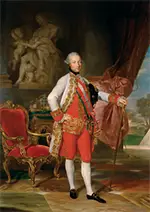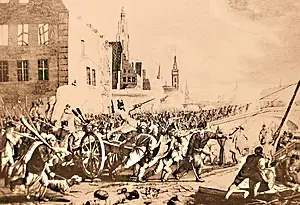The Brabant Revolution
The Brabant Revolution was a short-lived uprising against Austrian rule in the Low Countries that resulted in an infant independent state of Belgium. This occurred in the late 18th Century.  The Low Countries, comprising what is now Belgium and Luxembourg and the Netherlands, were at that time under the hegemony of the Holy Roman Empire. The Empire had taken over the Burgundian Circle in 1714, after the War of the Spanish Succession, and termed it the Austrian Netherlands. Ruling the empire at that time was Empress Maria Theresa. Her husband, Joseph II (right), was elected Holy Roman Emperor in 1764. The co-rulers considered themselves Enlightened absolutists. After she died, in 1780, Joseph introduced reforms designed to give the people living within the confines of the Empire more freedoms. One of his first acts was the Edict of Tolerance, which removed significant privileges that the Catholic Church then enjoyed. Another of Joseph's initiatives was to make administration of the Empire's various provinces more central. He set up both a General Council of Government and a Sovereign Council of Justice, single instruments to preside over the legislative and judicial arms of the Empire's governance. These actions removed significant freedoms from the provinces and member states, who had been enjoying relative autonomy. A small armed uprising against Joseph and his reforms was unsuccessful, but the emperor did get the message and nullify his governmental reforms; he did not repeal the Edict of Tolerance, however. 
Opposition to imperial rule grew. One of the emperor's more outspoken critics was a lawyer, Henri Van der Noot (right), who claimed that the reforms violated longstanding political principles. He gathered many to his cause and became an opposition leader, setting up headquarters in the city of Breda, in the Dutch Republic, and building an army. Other prominent individuals pursued similar goals and then, in 1789, formed a Brabant Patriot Committee, named after the Estate of Brabant, which Joseph II had disestablished. 
In October of that year, in the shadow of the beginning of the French Revolution, an army of a few thousand men marched from Breda into the Austrian Netherlands, determined to remove Joseph II's influence. Imperial troops were up to the task, turning up to defend the empire; however, the rebels won the day, near the town of Turnhout. News of the victory brought many more to the rebel cause, and they soon claimed the major city of Ghent. They carried on, administering defeat after defeat, taking Brussels and forcing the imperial army to coalesce behind the walls of Luxembourg. In just a few short weeks, the rebel army had won control of a large amount of territory. Leaders of the revolution formed a new entity, the United Belgian States, which launched on Jan. 11, 1790 and was run by a Sovereign Congress. Not long afterward, factionalism took hold. Van der Noot and his Austria, meanwhile, was too busy with other matters to intervene. Joseph II had contracted a lingering illness; at the same time, imperial troops were fighting in the east, against the Ottoman Empire. Left with a free hand, the Statists implored other European powers to recognize their nascent state; none did. 
Joseph II died in February 1790. His brother Leopold II succeeded him, made peace with the Ottoman Empire, and turned his fury on the United Belgian States. Imperial troops invaded and found a land in disarray. The Statists cobbled together an army and fought, at Falmagne, on September 28. The Empire was victorious, there and elsewhere. The Sovereign Congress, seeing the writing on the wall, dissolved itself on November 27. Six days later, Brussels surrendered, and the Empire was once again master of the Austrian Netherlands. Concurrently, people in the Prince-Bishopric of Liége had risen up against imperial rule, also in 1789, forcing the leader, César-Constantin-François de Hoensbroeck, to leave and setting up a republic in his wake. After subduing the Belgian States, imperial forces occupied Liége and forced the surrender of that as well. |
|
Social Studies for Kids
copyright 2002–2024
David White




